Rubik's Cube Made Easy - Never Forget How to Solve the Cube Again!
by thrashercharged in Living > Toys & Games
47813 Views, 57 Favorites, 0 Comments
Rubik's Cube Made Easy - Never Forget How to Solve the Cube Again!
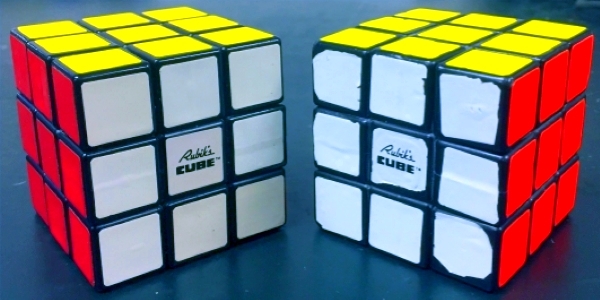
Did you learn to solve the cube once, then got out of practice and eventually forgot the moves? Or are you looking for a simple solution with the fewest hard to remember moves? Then this solution is for you – it’s by far the easiest solution that you will remember – even without frequent practice.
This is my method for solving the Cube from my high school days in 1980 when the cube had just been introduced into the U.S. and was wildly popular. And yes, those are both original Cubes, the right one is my first Cube (Hungarian made!) with original stickers - lubed with silicone (that's what we used back in the day) and well worn!
In these past 30+ (edit: going on 40!) years many solutions have been presented. The fastest methods which involve recognizing numerous patterns and memorizing pattern specific moves; the more patterns and moves memorized the better - emphasize efficiency and speed, but require a near photographic memory and constant practice. Then there are solutions that use many repeated moves with lots of steps so they’re slower but don’t require near as much memorization or thought as they rely on robotic repetitive processes and more “muscle memory”. But to keep this muscle memory fresh frequent practice is still required.
My approach is different and falls between these two extremes.
Warning! I'll go ahead and say it now - this guide is not for the total cube newbie that's never touched a cube before - I'm writing this for the person that's had some experience and either couldn't get past a certain point or has solved it before and thinks the method they used was too difficult and hard to remember. I don't even walk you through solving that first slice - I assume you're experienced enough to get that first slice by yourself.
A Little History... Most Cube Solutions Fall Under 2 Methods:
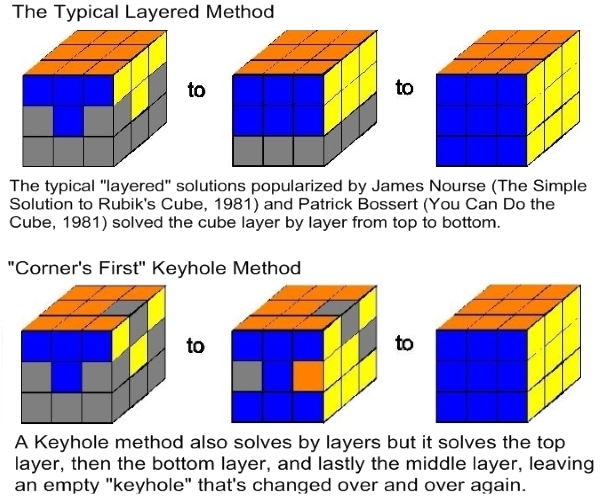
The vast majority of Rubik’s Cube solutions are all variations on Nourse & Bossert’s layered solution. These types of solutions required a lot of moves, and the series of moves are not easy to understand, hence they rely on muscle memory and are difficult to retain without frequent practice. The main problems come in that last slice – having 2 slices already completed, any moves on that last slice cannot mess up what you’ve already done, so the moves to finish the last slice are difficult and time consuming.
The keyhole method gets its name from the fact that you’ll leave an unsolved edge space on the first side that will be used a keyhole that’s changed over and over again as you solve other edge pieces with no regard as to what’s being put in that space until the very end. Thus there’s no need to waste time putting a correct piece in that edge space early in the game. The edge piece that’ll become your keyhole is arbitrary – you’ll just leave the last remaining edge piece on that first side unsolved until the end.
The keyhole method shares some moves with the layered solutions but since the middle slice isn’t completed until the end it’s easier to complete the bottom slice and the moves are more easily understood. You end up only needing to move edge pieces along the middle slice, and those moves are generally the easier ones.
This solution is a keyhole method.
Cube Notation: I Will Use These Typical Cube Symbols:
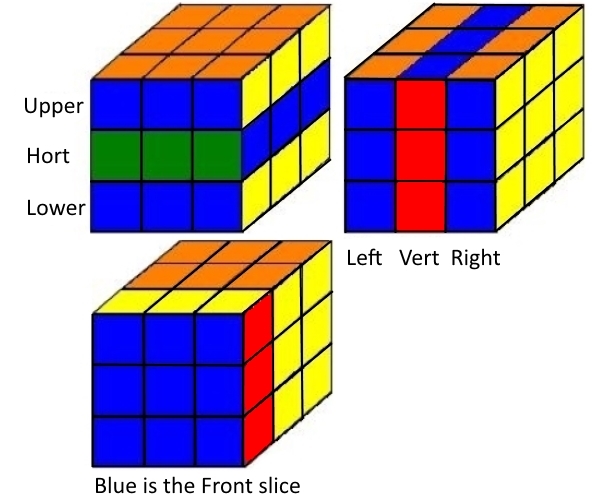
- U for the top (Upper) slice, B for the bottom
- L for the left hand slice, R for the Right
- F for the front slice
- H for the horizontal slice between the top and bottom sides)
- V for the vertical slice (between the left and right sides).
The letters by themselves mean to rotate that slice one quarter turn clockwise (CW), and the ‘ symbol means turn one quarter turn counterclockwise (CCW). 2 means two quarter turns (a half turn).
For example, U F2 L’ means to rotate the upper slice clockwise one quarter turn, the front slice CW twice (half way around), and the left slice CCW one quarter turn.
- Look directly at the specified side indicated to determine which direction is CW or CCW
- For the vertical slice V look from the right side to determine the CW direction
- For the horizontal slice H look from the top side to determine the CW direction
These are the only slices we'll turn. Unlike other solutions, I don't turn the back slice, or turn 2 adjacent slices so there's no need for knowing the full "Singmaster" notation. (Yes, David Singmaster is a real person, early cube expert and developed the full official cube notation - Google him.)
The General Idea - Position & Orientation Defined
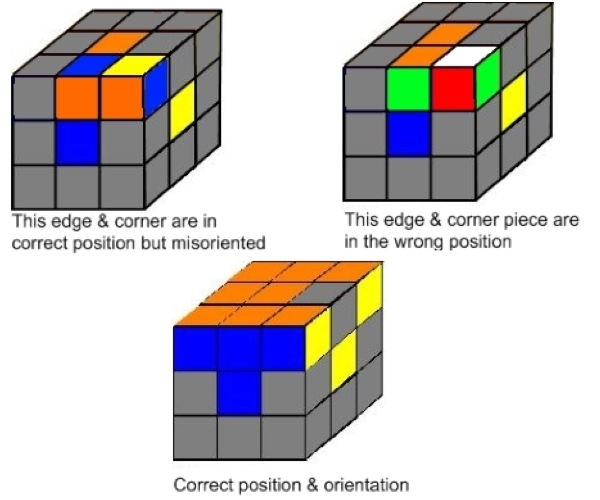
The general idea for solving the cube is to first put pieces into their correct position (i.e, where they belong) and later rotate the pieces into their proper orientation (i.e., turn the pieces so they face the right way).
There are 7 steps in this solution and 7 series of moves.
Step 1: Complete Side 1 corners or the whole slice except for 1 keyhole, your choice.
Step 2: Position the Side 2 bottom corners
Step 3: Orient the Side 2 bottom corners
Step 4: Complete the edge pieces of Side 2 (and Side 1 if you skipped corners in Step 1)
Step 5: Fill in the keyhole
Step 6: Position the middle slice edge pieces
Step 7: Orient the middle slice edge pieces
And you're done!
(Actual Step 1) Solve One Slice of the Cube
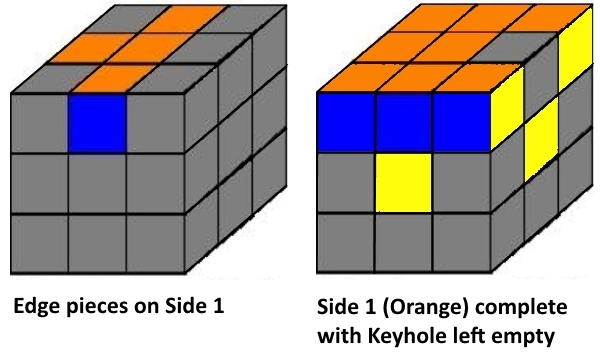
So let's get started! Instructables automatically labels any slides after the intro as Step 1, 2, etc. no matter what they really are so this is finally the real Step 1 - solving one slice of the cube. This first solved slice will be referred to as Slice 1 or Side 1. I always do the orange side first as the orange pieces stand out and are easiest to spot.
I really have a hard time writing a guide to solve that first slice so I'm going to sort of leave that up to you and assume you can do that on your own. Yes I know this is a cop-out but come on, do you really need a step by step guide for doing the first slice? I didn't think so. I will give you some hints though if you're a total newbie to the Cube. Do either the edge pieces first, then do the corner pieces, or vice versa. Just don't mix doing edges and corners haphazardly, do all of one type first, then tackle the other.
Only do 3 edge pieces (correct position & orientation) and leave a keyhole (empty edge piece). It doesn't matter which color edge piece you leave empty, just do the 3 easiest. It’s ok if you do all 4 edge pieces but you’re wasting time on that last one. Put the 4 corners into their correct position & orientation without messing up the edge pieces (if you did edges first), and without messing up any corner pieces previously done.
Use the middle and bottom slices as transitional places to move pieces in and out of since it doesn't matter how they're messed up at this point.
Note that solving a Slice is not the same as solving a Side – solving a Slice is harder as the edge pieces must also be correct. Solving a Side usually just means all the colors match on one side with no regard to whether the edges are correct or not, which really does no good whatsoever. You must solve a Slice here (and hence will have almost 1/3 of the cube complete – with the exception of the keyhole.) Having said that however, I will interchangeably be referring to your first solved slice as either Slice 1 or Side 1 from now on – we all understand the completed side is actually a slice, right?
Again, if you're a total cube newbie I'm sorry I don't have a step by step to solving that first slice but if you really want to remember how to do the cube without looking at this (or any) guide ever time, you need to know the cube well enough to solve at least that first slice on your own. Really.
When you have your top slice looking like the illustration above with the empty keyhole, you're ready to move on to Step 2.
(Actual Step 2) Position the 4 Corner Pieces of Side 2
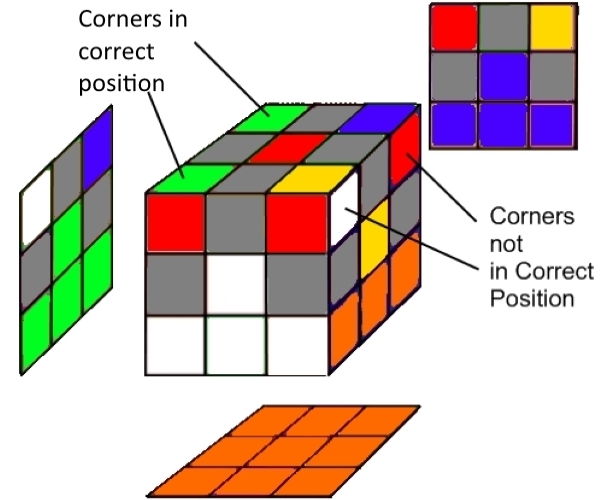
Finally - some real instructions and your first series of moves! But be warned - you're about to tackle the Side 2 corners (the Bottom side, opposite Side 1 which you just did) and they are probably the hardest part of solving the Cube because there's so many variations in position and orientation for these corners.
Turn your cube around so that you're looking at Side 2. Rotate side 2 (Red on my cube since Red is opposite Orange on the original Hungarian made cubes) until either two or four corner pieces are in the correct position (location). Remember what I mean by correct position: look at the center cube of each side – that’s the correct color for that side. So if a corner has a Red, Yellow, and White center piece on each of its sides, then the Red, Yellow, White corner piece is the one that belongs there. Any other colored corner piece would be wrong in that corner. So keep rotating slice 2 (Red) until two or four pieces are in their proper position.
Note that we’re only looking to put pieces in the correct position at this stage of the game, not correct orientation! The pieces just need to be in their right place, not necessarily turned correctly. Just about all the simpler cube solutions will put pieces into their correct position first, and later orient these pieces properly.
You can always turn Side 2 so that at least two corners are correctly positioned! Although you may see cases where one piece is correctly positioned and 3 incorrect, you need to ignore those cases! Just keep rotating side 2 and you should eventually see at least two pieces in the correct position.
If the 4 corners just happen to fall into the correct position you got lucky and you’re done with Step 2. Go ahead and skip to step 3. This would be one of those cases where just by accident something fell into place and saved you some steps (and time – between 5 to 15 seconds!). Unfortunately this doesn’t happen very often.
(Step 2a) Swapping Two Adjacent Corners
Note: Step 2a is ONLY for swapping two adjacent corners! Adjacent Corners are in line with each other on the same edge. If you need to swap 2 diagonal corners go to Step 2b!
See Fig 2a – the Red/White/Yellow and Red/White/Green need to swap. This scenario seems to happen most frequently. This will add 8 steps and about 5 to 10 seconds to your time.
Hold the cube as shown with Side 2 (Red) facing you and the corners to be swapped on the top slice. The 2 correctly positioned corners will be on the bottom slice. Now do Series1.
Series1: Swap 2 adjacent corners
B’ F B R’ B R B’ F2
You’ll probably have to memorize how to begin this series (turning the bottom and then the face) but after that if you understand what it’s doing the rest of it should come to you and you shouldn’t have to memorize it.
I’ve seen this series presented in other solutions in a slightly different way. Some are a totally different set of moves, others are the same as this one but they hold the cube a bit differently. I prefer this way because I do not like twisting the top, I’d rather twist the bottom & right side - this way my right hand does all the twisting & it’s faster for me.
(Step 2a Continued) Series1 Step by Step in Detail
I promised I'd explain each move in detail so they're better understood so let's dive in and analyze Series1 step by step:
Label the four Side 2 corners as shown in the image above:
BL = bottom left, BR = bottom right, UL = upper left, UR = upper right
Note that UL and UR will be swapped. All the “action” happens on the Face and Right Side. The objective of the 1st three moves: Keep BL where it is, move BR to the original UL position & UR to lower right rear.
(Step 2a Continued) Series1 Analysis: B’
B’ F B R’ B R B’ F2
B’: Turn the bottom slice Counterclockwise (CCW, referenced by looking into the bottom face)
This moves BL to the lower left rear of the cube for safekeeping and BR into the original BL position.
Hold the cube in your left hand (LH), holding the back slice, LH thumb on left slice and LH fingers on right slice. Put your right thumb on BL & turn the bottom slice CCW.
Hint to memorize this move: Think about moving BL back to the lower left rear for safekeeping
(Step 2a Continued) Series1 Analysis: B’ F
B’ F B R’ B R B’ F2
F: Turn the Face clockwise
Remember the 2 corners needing to be swapped are up in the top slice in the UL & UR positions. You're going to turn the Face clockwise and move that UR corner to the bottom slice. This moves BR to the original UL position (for safekeeping), UL to the original UR position, and UR to the original BR position
Keep your index finger on UR when you turn the face and keep your finger on it when you do the next B move as a reminder of what to do next.
Hint to memorize this move: Think about moving the 2 corners needing swapped - moving the original UR down to the lower right face of the cube – this is where keeping the index finger on this original UR corner piece helps.
(Step 2a Continued) Series1 Analysis: B’ F B
B’ F B R’ B R B’ F2
B: Turn the bottom slice clockwise (referenced by looking into the bottom face)
Your index finger is still on one of the corners that needs swapped right? Put that corner piece into the back. This moves BL back to its original BL position and UR to the lower rear right of the cube. Notice also that UL has been placed into the original UR position.
Hint to memorize this move: this is where keeping your index finger on UR in the last step helps – think about moving your index finger to the back of the cube for this step. You're moving that corner piece that needs swapped to the back of the cube. Keep your index finger on this corner as a reminder of what to do in the next step too!
(Step 2a Continued) Series1 Analysis: B’ F B R'
B’ F B R’ B R B’ F2
R’: Turn the right slice counterclockwise (referenced by looking into the right side)
The other corner piece that needs swapped is sitting in the current UR position. And the corner piece that you've been tracking with your RH index finger is now in the back on the bottom slice (you are still keeping your RH index finger on this corner aren't you?). Turning the R slice CCW will put the corner with your index finger to the top slice (still in the back) and the other corner piece that needs swapped gets put onto the bottom slice.
This moves UL to the original BR position and UR to the upper rear right of the cube. Notice also that UL is now in the original BR position.
Hint to memorize this move: your right index finger was still on that original UR corner right? Shift your LH grip on the cube by holding it with your LH thumb on Face 2 and your LH fingers on Face 1. Now put your thumb on the cube in the upper right front (that's the other corner that needs flipped). So just think about moving your index finger up. This will naturally make you want to turn the Right slice counterclockwise, putting those 2 corners that need swapped into the positions show in the illustration.
(Step 2a Continued) Series1 Analysis: B’ F B R' B
B’ F B R’ B R B’ F2
B: Turn the bottom slice clockwise (referenced by looking into the bottom face)
The corners that need swapped are diagonal to each other, so you want to put them adjacent to each other. So turn the Bottom slice clockwise.
This moves BL to the original BR position and UL to the lower rear right of the cube.
Note that UR and UL are now adjacent to each other in the rear of the cube and have been swapped!
Hint to memorize this move: Realize that UL was in the lower right front of the cube UR is in the upper right rear. They need to be next to each other, right? UR is in the rear so UL needs to be in the rear too. So turn that bottom slice and place UL next to UR on the rear.
You’ve now successfully swapped UR and UL’s positions!
(Step 2a Continued) Series1 Analysis: B’ F B R' B R
The remaining 3 moves in Series1 are simply to move UR and UL back to their proper places (they shouldn’t be on the rear face!). Once you understand UR &UL are side by side in the rear these last 3 moves are almost intuitive:
B’ F B R’ B R B’ F2
R: Turn the right slice clockwise (referenced by looking into the right side)
This moves UR and UL back down to the bottom slice
Hint to memorize this move: Having UL & UR on the rear slice isn’t doing any good is it? You have to start moving them to the front face, right? So turn the right side and move UL & UR to the bottom slice. Notice also that this also brings BL back up to the top slice right next to BR – this is good! They need to be next to each other anyway right?
(Step 2a Continued) Series1 Analysis: B’ F B R' B R B'
B’ F B R’ B R B’ F2
B’: Turn the bottom slice Counterclockwise (referenced by looking into the bottom face)
Hint to memorize this move: This move is pretty obvious. It moves UR and UL back to the front face where they belong.
Now you can see that the 2 corners UL and UR have already been swapped but the face (Side 2, Red) is just upside down! Also notice that Side 1 (Orange) has been put back together properly.
(Step 2a Cont) Series1 Analysis: B’ F B R' B R B' F2
B’ F B R’ B R B’ F2
F2: Turn Face (Red) clockwise twice (a full 180 degs)
Hint to memorize this move: Hopefully a hint isn’t needed! This simply puts all 4 corners back to their proper places and you’re done – the 2 adjacent corners have swapped places.
Go to Step 3.
Looking at the illustration, you’ll see that UR & UL are now not labeled properly to be Left and Right because they’ve swapped laces! Also notice that if you compare Side 2 now to the way it was at the start of Series1, the colors are oriented differently.
Hopefully you now fully understand what this Move Series is doing so that it’s not just a bunch of “black magic” moves to you anymore. Once you really understand it, you won’t have to blindly memorize the moves.
(Step 2a Alt) Alternative Moves for Swapping Two Adjacent Corners
Series1 alternative: F’ L F L’ F’ U’ F’ U F
Just to show there’s more than one way to accomplish the same task, especially at this early stage where there are lots of pieces that can be changed without care, my youngest son (Brayden, age 13) came up with his own series of moves for swapping 2 adjacent corners. See which you prefer, or come up with your own set of moves - the better you understand the moves, the more likely you'll remember them because you're not just relying on muscle memory anymore.
(Step 2b) Swapping Two Diagonal Corners
If your 2 corners that need swapping are diagonal to each other, follow Step 2b. Luckily this scenario happens less frequently than 2a (swapping 2 adjacent corners).
Hold the cube as shown in Figure 2b, with Side 1 in the back, Side 2 in the front and the 2 correctly positioned corners in the UL and BR positions.
You have 2 choices:
Perform Series1 and swap the 2 top corners. Now rearrange Side 2 (Red) and go back to the beginning of Step 2 where you're trying to match 2 corners to their correct positions and have 2 corners that need swapped. Those 2 corners that need to be swapped should land adjacent to each other instead of diagonal now. Doing Series1 once more will of course get the corners swapped into their proper places.
(If you're really unlucky, you may end up with diagonals needing swapped again and have to repeat this one more time before you get them adjacent but I don't think I've ever had this happen, in fact it may not ever happen.)
OR, do this series to swap the 2 incorrect diagonals:
Series1_diag: L F2 R’ F L’ F’ R L F2 L’ F
This diagonal series adds 3 more steps over the adjacent series. The choice is yours. Doing Series1 again takes more steps of course but you’ll have 1 less set of moves to memorize. Personally, I haven’t memorized Series1_diag (I admit - I found this series on the internet! It's not mine.) as I prefer to keep things simple and I just repeat Series1 again. Yes it’s slower but it's one less set of moves to remember and diagonals seem to happen less often than adjacents - don't know why.
Step 3: Orient the Four Corner Pieces of Side 2
So we're still working on the Side 2 corners. As I said before, the Side 2 corners are the hardest and most time consuming part of solving the cube! At this point, you should have Side 1 solved (except for the keyhole of course) and Side 2 corners should be all in their correct positions - if not, go back to Step 2 and go through it again.
Now that the 4 corners are in correct position, they need to be oriented (i.e. the colors must be turned properly so that their colors match the color of the center cube.)
There are 4 possibilities:
A. All 4 corners are correctly oriented. If this is the case, you’re done! Go to step 4.
B. 1 corner is correctly oriented and 3 are incorrect
C. 2 corners are correctly oriented and 2 are incorrect
D. All 4 corners are incorrectly oriented
Note: It is impossible for 3 corners to be correctly oriented and 1 incorrect. If your cube is this way, it’s been taken apart and put back together incorrectly.
Step 3a: Case A: All 4 Corners Are Correctly Oriented
You’re lucky – you’re done with Side 2 corners, saving you at least 10 seconds. Go ahead to Step 4.
Step 3b: Case B: 1 Corner Is Correctly Oriented and 3 Are Incorrect
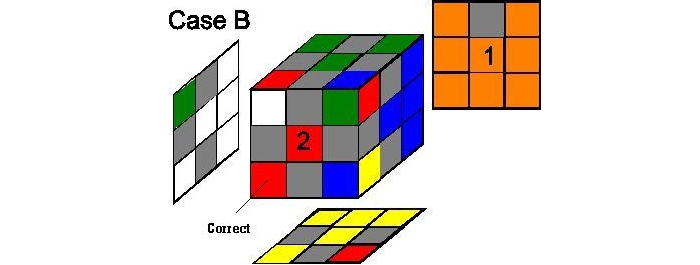
See the illustration above and position your cube the same way with the correctly oriented corner cube in the lower left, Side 2 facing you.
Perform the moves of Series2. If you’re lucky, you will only need to do Series2 once but you may end up needing to do it twice before until all 4 corners are correct, or you may have Case c after doing it.
In my experience, Case b appears less often than Case c.
I’ve seen this series presented in other solutions but they always hold the cube in a different orientation. I prefer my way because I do not like twisting the top, I’d rather twist the bottom - this way my right hand does all the twisting & it’s faster for me (probably because I’m right handed.)
Series2: Rotate 3 corners B’ F2 B F B’ F B F2
This series will rotate the three corners UL, UR and BR while keeping them in their place.
Step 3b Case B Continued: Series2: Rotate 3 Corners
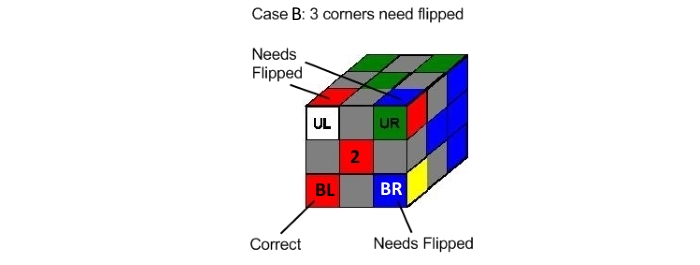
Series2: Rotate 3 corners B’ F2 B F B’ F B F2
This series will rotate the three corners UL, UR and BR while keeping them in their place. Let's go in for a deep dive look at this series of moves.
Label the four Side 2 corners
BL = bottom left, BR = bottom right, UL = upper left, UR = upper right
Key to memorization: Notice that Series2 only turns the Bottom slice and the Face and they alternate with each other. The Bottom alternates between B’ and B, and the Face only turns clockwise or twice.
Step 3b Case B Cont: Series2 Detailed Analysis: B’ F2 B F B’ F B F2
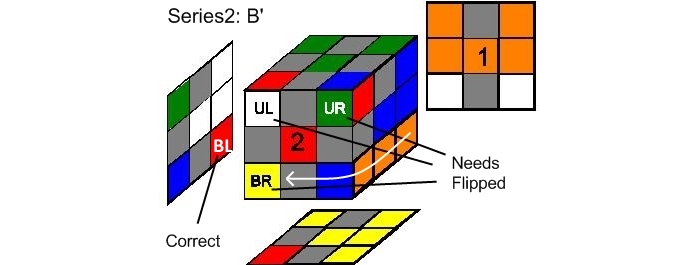
Series2: Rotate 3 corners: B’ F2 B F B’ F B F2
B’: Turn the bottom slice Counterclockwise (referenced by looking into the bottom face)
This moves the original correct corner BL to the lower left rear of the cube for safekeeping and brings BR into the original BL position.
Hint to memorize this move: Think about moving the original correct corner BL back to the lower left rear for safekeeping.
Step 3b Case B Cont: Series2 Detailed Analysis: B’ F2 B F B’ F B F2
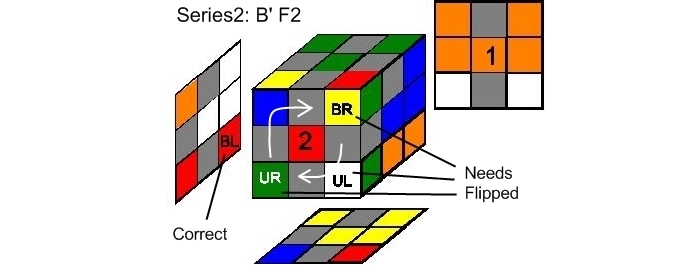
Series2: Rotate 3 corners: B’ F2 B F B’ F B F2
F2: Turn the Front Face 90 degs twice for a total of 180 degs.
This moves the 2 upper corners UL and UR to the bottom and brings BR to the top.
Hint to memorize this move: All the “action” happens on the bottom slice in this series of moves, so we need to move those 2 upper corner pieces down to the bottom slice.
Step 3b Case B Cont: Series2 Detailed Analysis: B’ F2 B F B’ F B F2
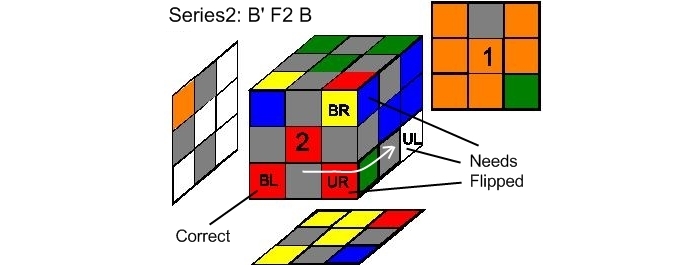
Series2: Rotate 3 corners: B’ F2 B F B’ F B F2
B: Turn the bottom slice clockwise (referenced by looking into the bottom face)
This moves the original correct corner BL back to the front face, back to its original location. UL moves to the back lower right, and BL is now next to UR.
Hint to memorize this move: you’re moving the original correct corner BL back from its safekeeping spot into its original location, and at the same time putting one of the corners that needs flipping into the back. Again, all the “action” happens on the bottom slice so you just turned the face in the last move, so now it’s time to turn the bottom.
Step 3b Case B Cont: Series2 Detailed Analysis: B’ F2 B F B’ F B F2
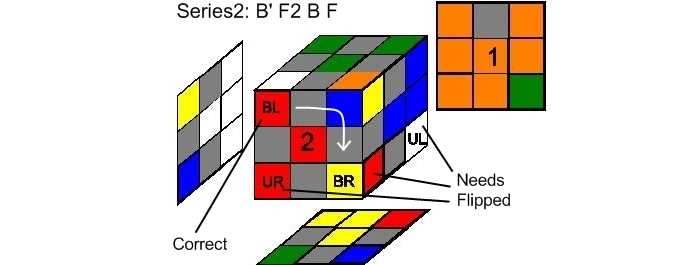
Series2: Rotate 3 corners: B’ F2 B F B’ F B F2
F: Turn the Front Face clockwise
Remember all the action happens on the bottom slice, so we're putting the 2 corners that need flipping onto the bottom.
This moves the original correct corner BL clockwise into the Upper Left corner and UR & BR rotate to the bottom slice. Notice that BR and UL are now next to each other.
Hint to memorize this move: Now it’s the Face’s turn to be moved again, and all the action happens on the bottom slice. We’ll be moving the original correct corner BL clockwise around the front face as we go through this series, so think of moving that original correct corner piece BL once clockwise, and moving the 2 corner pieces that need flipping on the Front slice to the bottom.
Step 3b Case B Cont: Series2 Detailed Analysis: B’ F2 B F B’ F B F2
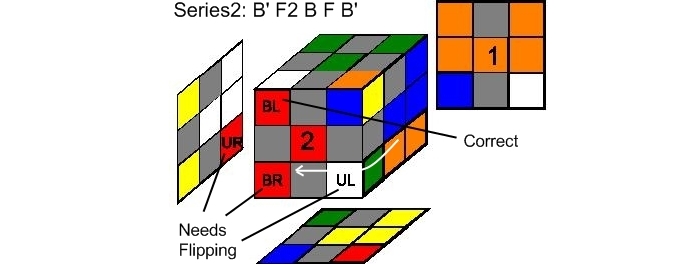
Series2: Rotate 3 corners: B’ F2 B F B’ F B F2
B’: Turn the bottom slice counter-clockwise
Bring that corner that needs flipping from the back to the front, and put another corner into the rear for safekeeping.
This move will bring UL back to the front face, and UR gets pushed to the bottom left rear.
Hint to memorize this move: Now it’s time to turn the Bottom again since we just turned the Face in the last move. So we put UR into the back for safekeeping and bring UL up to the front again. This also puts BR right next (adjacent) to BL where it should be.
Step 3b Case B Cont: Series2 Detailed Analysis: B’ F2 B F B’ F B F2
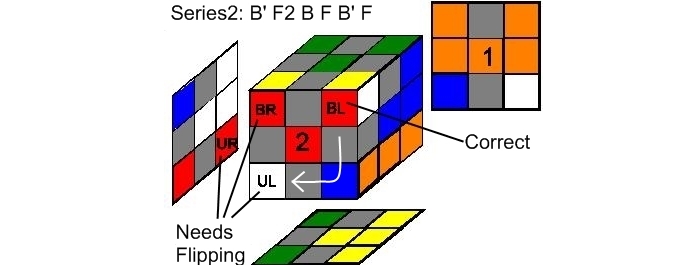
Series2: Rotate 3 corners: B’ F2 B F B’ F B F2
F: Turn the Face clockwise.
This moves the original correct corner BL clockwise to the upper right position. BR and UL are moved down to the bottom slice.
Hint to memorize this move: Time to turn that Face again.
You can see that BR & BL are correctly oriented and next to each other on the left side, so simply twist the face clockwise once and BR & BL will be placed into their proper spots on the upper slice. Also, remember we said that the original correct piece BL would be moving clockwise throughout this series?
Step 3b Case B Cont: Series2 Detailed Analysis: B’ F2 B F B’ F B F2

Series2: Rotate 3 corners: B’ F2 B F B’ F B F2
B: Turn the bottom slice clockwise (referenced by looking into the bottom face)
Moves UR back to the front face.
Hint to memorize this move: It’s the Bottom slice’s turn to move. You can see that UR & UL are correctly oriented and next to each other on the left side, so just turn that bottom slice and put them onto the front face.
Step 3b Case B Cont: Series2 Detailed Analysis: B’ F2 B F B’ F B F2
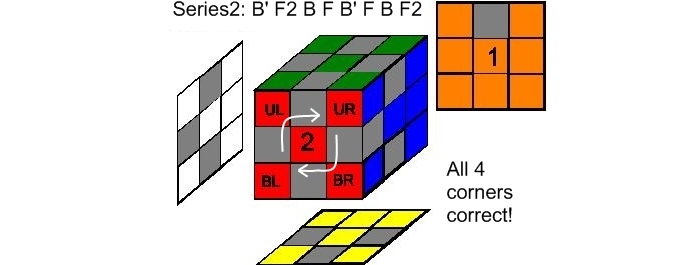
Series2: Rotate 3 corners: B’ F2 B F B’ F B F2
F2: Turn the front face twice (i.e. 180 degs)
This moves the 4 corners back to their proper positions. If all 4 corners come out oriented correctly as shown in the illustration then you’re done – proceed to Step 4.
If not, then you must be seeing Case b again so repeat Series2 one more time.
Hint to memorize this move: You can see that the front face is done and just upside down, so just twist the front face and fix that and you’re done!
Step 3c: Case C: 2 Corners Correctly Oriented and 2 Incorrect
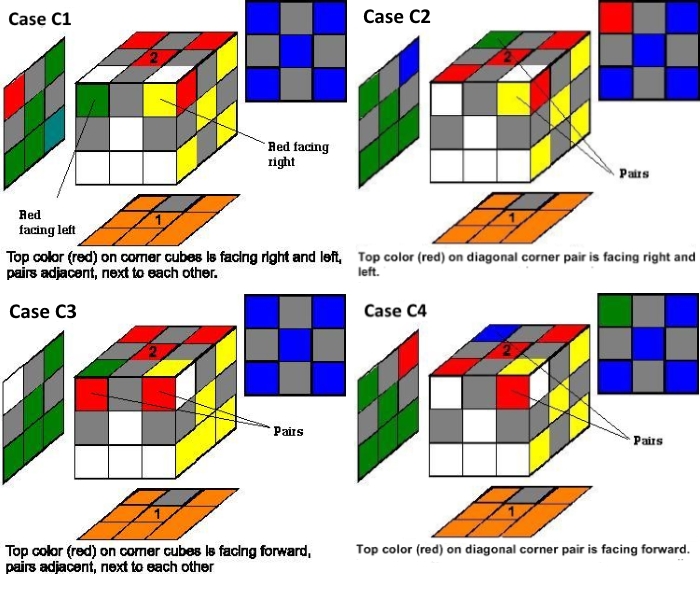
Case C - 2 corners correctly oriented and 2 misoriented - seems to occur most frequently for me. There are 4 ways these corner cubes can be oriented in Case C (shown above). You have 2 choices with Case C:
1. Do Series2 and rotate 3 corner cubes around, maybe multiple times, and eventually you’ll see Case B. Then do Series2 one more time. This method usually takes more time and moves but of course it’s one less set of moves to remember. But it’s not my preferred method.
2. This second choice requires more thought, so if you’re more inclined to blindly memorize the moves you might prefer the first option of doing Series2 multiple times, but this second method is what I prefer.
The concept of this second method is simple. Since you have 2 incorrectly oriented corner cubes, you can flip one of them, and in the process of doing so you’ll have a really messed up cube. How would you return your cube back to the way it was?
You’ll simply reverse the steps, right? But of course that doesn’t help you as you’ll end up right back where you started, with a pair of corner cubes that need to be flipped.
So, the secret is to flip one of the corner cubes (I do UR the upper right), then turn the top slice so that its partner (the other corner cube that needs to be flipped) is now in the same location (UR) and then reverse the steps. This returns my cube back to the way it was, but my flipped corner remains flipped (not undone) and the other corner that needed to be flipped actually got flipped in the reversal of the steps! It’s actually a very simple process but does require you to identify the matched corner pairs.
I'll warn you, the next few slides are going to make this sound a lot more complicated than it really is. It's just hard (at least for me) to explain in words because there's so many ways the corner cubes can be situated, but it's really a very simple concept so please bear with me.
Step 3c: Case C Cont: 2 Incorrect Corners Facing R&L
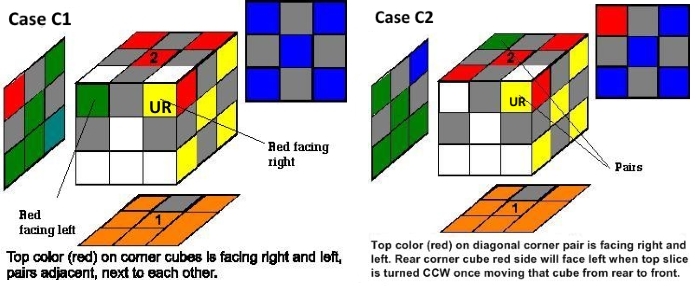
There are 4 possibilities for the Case C pairs (A pair being one corner cube and its partner where both need to be flipped).
Hold cube with Side 2 (Red) facing up. Hold the cube so that the 1st corner to be flipped is on the Upper Right (UR) position facing you. Look at it – is the top color facing the right or is it facing you? Look at the illustrations above for clarity. The pairs can either be adjacent (next to) each other or diagonally across from each other. The top color (Red) of the UR corner cube can either be facing the right or it’s facing you.
The illustrations above show the 2 incorrectly oriented corner pieces with Side 2 (red) facing right & left.
In the above 2 illustrations I'm showing the 2 cases where the UR cube with Red is facing right, and it's partner corner (which will be facing left) is adjacent to it in one image (Case C1), and diagonal to it in the other (Case C2).
Note that if the partner piece is diagonal, the red side is actually facing to the rear when that corner piece is sitting on the rear slice, but when you turn the top slice CCW (i.e., do a U' move) it'll bring that diagonal corner piece to the front face into the UL position, and now the red side will be facing left. Clear as mud? Look at the illustrations above carefully and hopefully you'll understand better.
In both pictures, the red side of the UR corner is facing right and the UL piece's red side is facing left, but in the diagonal case a U' move needs to be done first to put that partner corner piece into the UL position on the face. After you do this, that partner piece's red side will be facing left.
Step 3c: Case C Cont: 2 Incorrect Corners Facing Forward
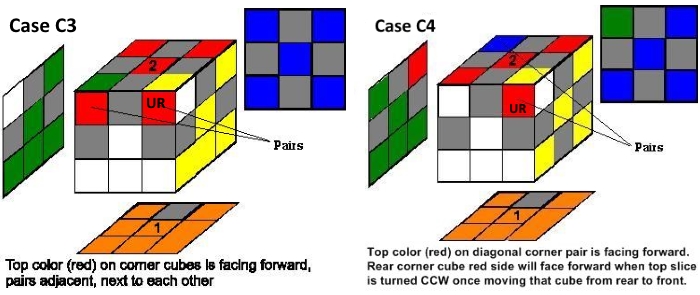
I'll repeat the instructions from the previous slide.
There are 4 possibilities for the Case C pairs (A pair being one corner cube and its partner where both need to be flipped).
Hold cube with Side 2 (Red) facing up. Hold the cube so that the 1st corner to be flipped is on the Upper Right (UR) position facing you. Look at it – is the top color facing the right or is it facing you? Look at the illustrations above for clarity. The pairs can either be adjacent (next to) each other or diagonally across from each other. The top color (Red) of the UR corner cube can either be facing the right or it’s facing you.
In the above 2 illustrations I'm showing the 2 cases where the UR cube with Red is facing forward, and it's partner corner (which also has the Side 2 color (red) facing forward) is adjacent to it in one image (Case C3), and diagonal to it in the other (Case C4).
Note that if it's diagonal, it's actually facing to the left when that corner piece is sitting on the rear slice, but when you turn the top slice CCW (i.e., do a U' move) it'll bring that diagonal corner piece to the front face into the UL position, and now the red side will be facing forward. Clear as mud? Look at the illustrations above carefully and review the last slide and hopefully you'll understand and see the difference.
Again, remember for the diagonal case, you need to do a U' move to put that partner piece into the UL position on the front face. After doing this move, the red side of that UL piece will be facing forward.
Step 3c: Case C: Series3: Flips 2 Corner Cubes to Re-orient Them
So to summarize, Case C has a pair of corners needing to be flipped. You've identified the pairs that need flipping, and whether their Side 2 color (Red) is facing right & left or facing forward. I know I'm repeating myself for those of you that already get it, if so, please bear with me as I'm trying to make this as clear as possible.
You want to put one of the corners that needs flipping in the UR position. Your objective now is to put that UR corner cube onto the bottom slice and manipulate it so that when you move it back up into the UR spot, the Red side is facing up. You'll do this using the Series3 moves, and of course they'll be different depending on whether your pairs have the Red side facing right & left or facing forward.
Then you'll move the other corner cube that needs flipping into the UR spot and reverse the moves, resulting in both corner cubes flipped so their Side 2 color (Red) is facing up.
Now, this is important for your understanding - If you don't want to hassle with learning different moves depending on whether the Red side is facing R&L or forward, pick your preference (R&L or forward) and turn the cube around in your hands until a corner of your preference is in that UR spot! (i.e., if a R&L corner is in the UR spot now and you prefer to do the Forward moves, turn the cube around and hold it so that a different side (center cube) color faces you and a Forward corner is in that UR position.
I know this sounds complicated, and this is the hardest part of the solution to understand, but once you get it, it's really quite simple and intuitive (really!). Now let's get on with doing Series3 and flip those 2 corner pairs!
Step 3c: Series3a: Flips 2 Corner Cubes If Top Color Is Facing R&L:
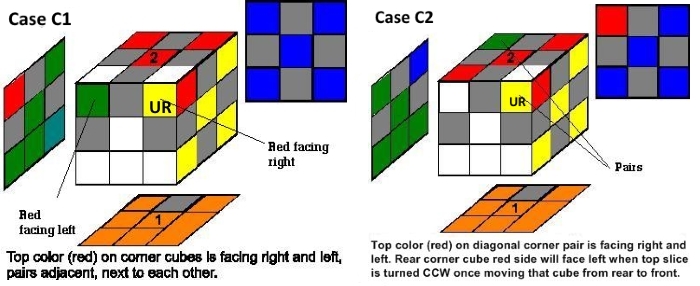
Note: Series3a is only for flipping 2 corner cubes with the Side 2 color (red) facing right and left!
- Hold the cube so that the first corner you want to flip is in the Upper Right (UR) position.
- Is the Side 2 color (Red) facing R&L? Yes? Do Series3a.
- Is the Side 2 color (Red) facing towards you (Forward)? Then do Series3b (next slide) instead.
- Do you have a preference (i.e., do you like doing Series3a more than Series3b or vice versa?) If so, turn the entire cube around in your hands so that the UR corner has your preference (a R&L corner or Forward corner) and do the corresponding Series3 moves.
Series3a: Flips 2 corner cubes if top color is facing right and left:
- Part 1: R’ B’ R B R’ B’ R
- move the partner corner into the same position (UR) using U' if the partner piece is adjacent, or U'2 if diagonal
- Part 2: R’ B R B’ R’ B R (reverse of 1st part - you’re basically undoing the moves with the partner piece)
This is fairly self explanatory so I won’t go through the trouble of breaking down each step with an illustrations. Essentially you’re just moving the corner cube to the bottom slice and flipping it so that the red side faces up, then moving the partner piece into that UR position and reversing the moves, which will flip that partner piece so the red side faces up too.
To move that partner piece into the UR position you'll do a U' move if the partner piece is adjacent, and a U'2 move if it is diagonal.
Step 3c: Series3b: Flips 2 Corners If Top Color Is Facing Forward:
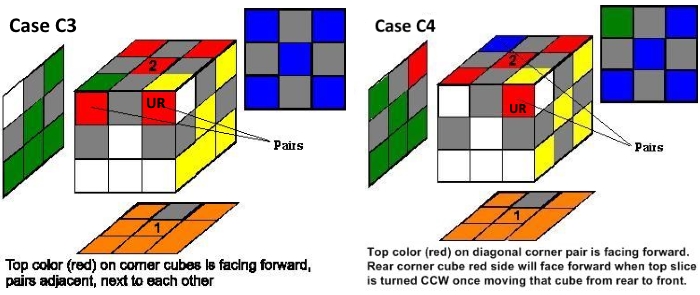
Note: Series3b is only for flipping 2 corner cubes with the Side 2 color (red) facing towards you (Forward)!
- Hold the cube so that the first corner you want to flip is in the Upper Right (UR) position.
- Is the Side 2 color (Red) facing R&L? Yes? Do Series3a (Previous Slide).
- Is the Side 2 color (Red) facing towards you (Forward)? Then do Series3b (below) instead.
- Do you have a preference (i.e., do you like doing Series3a more than Series3b or vice versa?) If so, turn the entire cube around in your hands so that the UR corner has your preference (a R&L corner or Forward corner) and do the corresponding Series3 moves.
Series3b: Flips 2 corner cubes if top color is facing you (Forward):
Simply switch the order of Series3a and you have Series3b:
Part 1: R’ B R B’ R’ B R
move its corresponding partner into the same position (top right)
Part 2: R’ B’ R B R’ B’ R (reverse of Part 1)
(i.e., Series3a “undo” steps become Series3b “do” steps and Series3a “do” steps become Series3b “undo” steps)
After completing Series3b, you should be ready for Step 4.
Step 3c: Series3a/3b: Flips 2 Corner Cubes:
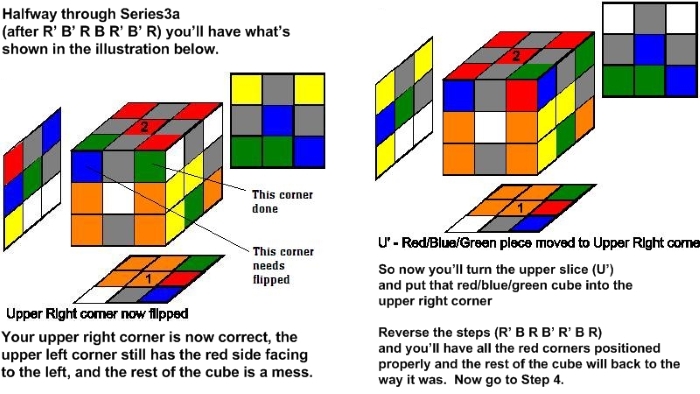
These 2 photos just help explain Series3 better using Series3a as an example.
Reminder: Series3a:
- Part 1: R’ B’ R B R’ B’ R
- move the partner corner into the same position (UR) using U' if the partner piece is adjacent, or U'2 if diagonal
- Part 2: R’ B R B’ R’ B R (reverse of 1st part - you’re basically undoing the moves with the partner piece)
- The left photo is after doing Part 1 (after 1st corner flipped).
- Now do either a U' or U'2
- The right photo shows the results after doing Part 2 ("undoing" Part 1 with 2nd corner flipped)
Series3b will be similar (Switch Part 1 and 2 around).
After completing Series3a or Series3b, you are ready for Step 4.
Step 3d: Case D: All 4 Corners Are Incorrectly Oriented
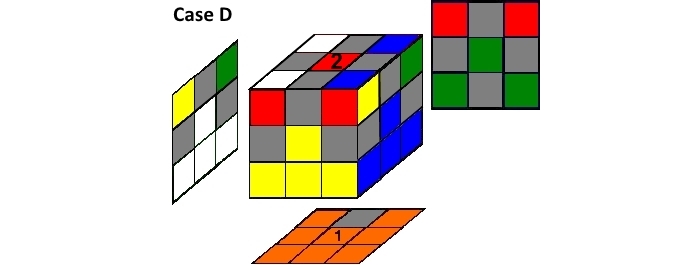
Finally, the last case for Step 3.
If all 4 corners are incorrectly oriented, you really got unlucky and you’ll have even more time and moves added to your solution. You can forget about achieving a personal best time if this is the case! You have two choices:
- Do Series2 once and turn Case D into either Case B or C
or - Perform Series3 twice (the 2nd time is for the 2nd pair).
1. Do Series2 once and turn Case D into either Case B or C:
Hold the cube with Side 2 (red) facing you as shown in the illustration above. Which side faces top or right doesn’t matter, just have Side 2 facing you and do the Series2 moves. You should end up with either Case B or C and you’ll continue to follow the steps for those cases.
Doing Series2 requires less thought – you just sort of blindly do the moves and it rotates 3 corner cubes around and you’ll end up with a Case B or Case C. But there’s nothing wrong with this approach, it’s just less efficient and takes more time.
2. Perform Series3 twice (the 2nd time is for the 2nd pair):
Using Series3 here requires a bit more thought but less memorization, in my opinion. Basically instead of just having a single pair to flip as in Case D, for Case D you have two pairs of corners that must be flipped! So you’ll have to do Series3 twice. The trick is, now you have to find the how the cubes pair up. '
The instructions that follow for finding the pairs will sound harder than it really is. It’s really quite simple so just bear with me – once you understand it, it’s easy. Each cube will only be properly paired with its correct partner! If you pair up a cube with a wrong partner, things won’t come out right!
Step 3d: Case D: All 4 Corners Incorrectly Oriented - Series3
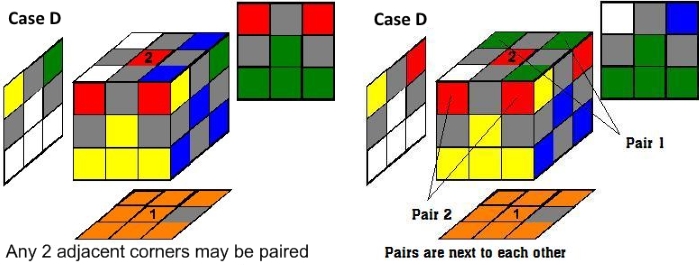
So you've decided to use Series3 twice for Case D. Good. Here's how you figure out how to pair up the corner cubes.
Hold the cube with Side 2 (red) facing up (meaning hold the cube so that the red center piece is up) and with the UR corner’s red side facing you. Now look at that Side 2 (red) slice - the top slice.
If the rear 2 corner’s top color (red) are facing directly opposite the 2 red corners that are facing you (forward) as shown by the left illustration, any 2 adjacent red corners may be paired together. What I mean is, you’ll either pair up the corners so that your 2 pairs will have both red sides facing you (forward), or your 2 pairs will have the red sides facing left and right. It’s your choice.
If the rear 2 corner’s top color (red) are facing right and left (as shown in the right illustration) then:
1. the top color (red) can either be facing the Right side and therefore its partner’s top color (red) will be facing the Left side (Pair 1 in that right illustration)
2. The top color (red) on both it and its partner will be facing you (Pair 2 in that right illustration)
In these illustrations, we just happen to have the pairs occur adjacent (next) to each other. But remember the pairs can also occur diagonally to each other too.
To summarize:
1. A corner with a red side that’s facing right must be paired up with a corner whose red side is facing left.
2. A corner with a red side facing you must be paired up with the other corner whose red side is facing you if it’s on the front, and if it’s on the back (diagonal) its red side will be facing to the rear.
Now perform Series3 for both pairs.
Do Series3a for pairs with red facing left and right, and do Series3b for pairs with red facing towards you. So Case D will require 15 additional steps over Case C because Series3 needs to be performed twice.
When you’re done with Step 3, you should have all four of your Side 2 corner pieces correctly positioned and oriented. You're ready for Step 4!
Step 3 Alternative: Alternate Series3 With 1 Less Step
Just to show there's more than one way to approach the Cube, here's some alternative moves for Series3 that accomplish the same thing but with 1 less step (courtesy of my boy):
Series3a_alt: If the top color is facing right (and left): R’ B2 R F B2 F’
then move its corresponding pair into the same position (UR) and reverse the steps: F B2 F’ R’ B2 R
Series3b_alt: If the top color is facing you: F B2 F’ R’ B2 R
then move its corresponding pair into the same position (UR) and reverse the steps: R’ B2 R F B2 F’
Whether you use Series3a / 3b or Series3a_alt / 3b_alt is entirely up to you. a_alt / b_alt has one less step but it’s slower for my hands to perform and seems less intuitive, but that may be just because I’ve been doing Series3a / 3b for over 30 years and the alt versions are new to me so they feel strange. Or come up with your own series of moves, you'll remember your own moves better! At this point you still have the entire middle and bottom slice available to mess up so your options aren't very constrained.
Step 4: Complete the Four Edge Pieces of Slice 2

Whew! The hard part is behind you now! Those corners are a real pain aren't they? That's because there's so many variations in how they can end up. From here on out, it gets better. Step 4 is the easiest by far - it's very intuitive.
Your cube should look like the illustration above with a completed Side 1 (except for the keyhole of course) and the four corners of Side 2 in position and correctly oriented. If not, you missed something - go back to Step 2 or 3 and go through them again.
Step 4 basically consists of using the keyhole in Side 1 to complete the edge pieces of Side 2.
The “keyhole” in Side 1 will always be messed up and will be replaced with another edge piece in this move (that’s why you left it empty) – you don’t care what happens with the keyhole.
Step 4: Complete the Four Edge Pieces of Slice 2
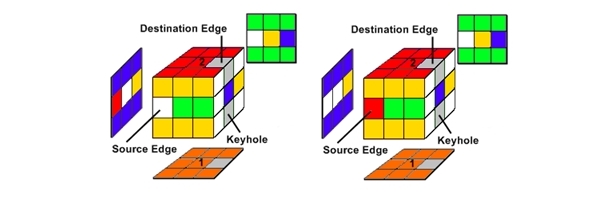
Hold the cube so that the keyhole is on the bottom slice, right side. Find your source edge piece in the middle horizontal slice and move the horizontal slice until that source edge piece is placed on the left side. Now find the proper empty destination edge spot in the top slice where this source edge piece fits and place it directly above the keyhole (i.e. it’ll be on the right side, top slice)
See the illustrations above. Note that the center color of the horizontal slice is arbitrary. Disregard the center color as you’re spinning the horizontal slice.
If your source edge piece Side 2 color (Red) is facing left as in the left illustration, do Series4a:
Series4a: R’ H’ R
If your source edge piece Side 2 color (Red) is facing you (forward) as in the right illustration, do Series 4b:
Series4b: R H’2 R’
This series is so self-explanatory I won’t bother detailing the steps out and explaining what each step does. This is one of the more intuitive moves I’d mentioned in the intro that don’t require memorization. You're basically turning the Right Slice, putting the keyhole piece and source piece into the middle slice and using the middle slice as a temporary passage to put the source edge into its destination spot.
If your source piece happens to be in either the keyhole or in the destination spot (but flipped the wrong way), you simply use either Series4a or 4b and move it out into the middle slice, re-position it and repeat Step 4.
Keep repeating Step 4 for all remaining Side 2 edge pieces.
That's it! You now have Slice 2 completely done and Slice 1 with only a keyhole missing. You're ready for Step 5!
Step 5: Fill in the Keyhole on Side 1

You should now have a top and bottom slice completely done with the exception of a keyhole. Hold the cube so that the keyhole is on the top right position, and move the horizontal slice so that the edge piece that belongs in your keyhole (aka the "Edge Piece that fits the Keyhole", aka the Target Piece) is on the left front face as shown in the illustration above.
If your "Edge Piece that fits the Keyhole" Target Piece is actually in the keyhole but flipped wrong, hold the cube as shown in Case C with the Keyhole in the top right position. Note that the grayed out edge cube in Case C is NOT the keyhole, I'm using Grey just to represent some arbitrary color we don't care about. The Case C keyhole is that blue/orange Edge piece that's turned wrong, and that blue/orange piece happens to be your Target Piece in this case.
There will be 3 possibilities for how the "Edge Piece that fits the Keyhole" Target Piece can be positioned.
- Case A: You're in luck. Doing Series5 once will put that Target Piece correctly in place.
- Case B: Sorry, you'll have to perform Series5 three times before it pops into place OR do Series5a.
- Case C: Do Series5 to move it into the horizontal slice, and repeat Step 5 again.
So regardless of how the Target Piece is oriented the simplest solution is to just do Series5. Doing Series5 will eventually get the Target Piece placed properly.
You can see how the time to solve the cube could vary again. Hopefully you get lucky and have Case A and doing Series5 just once will fill in your keyhole.
In detail:
Case A: Hold the cube as shown in the left illustration. (Keyhole on top right, Target Piece on Horizontal layer front side, left edge). Do Series5 and you're done. Go to Step 6.
Series5: Fill in Key hole: R’ H R2 H R’
Case B: Hold the cube as shown in the middle illustration. Either do Series5 three times or do Series5a once.
Doing Series5a kinda requires memorizing another series or moves but it's faster. I say kinda because it's really just the exact opposite of Series5 so it's pretty easy to memory and understand once you've understood how Series5 works. Want to try it and save some steps? Here it is:
Series5a: H (moves that Target Edge to back side) R H' R2 H' R (Opposite moves of Series5)
Once you're familiar with it, you'll recognize Case B without having to arrange the cube so it looks exactly like that middle illustration and you can just start out with that Target Piece on the back side, saving you from having to to that H move that starts Series5a, saving you a step. I just tell you to arrange the cube so it looks like the illustration for ease of explanation.
If you choose not to do Series5a and just do Series 5 three times, be aware that each time after doing Series5, you'll need to re-arrange the horizontal slice so it matches one of the 3 cases as illustrated above, then do the moves.
Starting from Case B, doing Series5 once will give you Case C.
Case C: Hold the cube as shown in the right illustration. Do Series5 once. This will give you Case A (after rearranging the horizontal slice). Do Series5 again and you're done. Go to Step 6.
Step 5: Series5 Analysis: R'

This Series is actually very intuitive, let’s break this down and analyze it in detail to help you better understand it. I'll use Case A as the example.
Series5: Fill in Keyhole: R’ H R2 H R’
R’ (Rotate Right Slice counter-clockwise looking from the right side)
will move the empty space Keyhole as well as a "Side 2 Edge Piece Opposite the Keyhole" to the Horizontal slice. Note that the "Edge Piece that fits the Keyhole" and the "Side 2 Edge Piece Opposite the Keyhole" are now diagonal to each other.
Note I'll keep labeling the piece that was the Keyhole as "Keyhole", but we really don't care about it at all anymore. After all, it was just a piece that happened to be in the keyhole temporarily, I'll just keep labeling it as "Keyhole" for clarity.
Step 5: Series5 Analysis: R' H
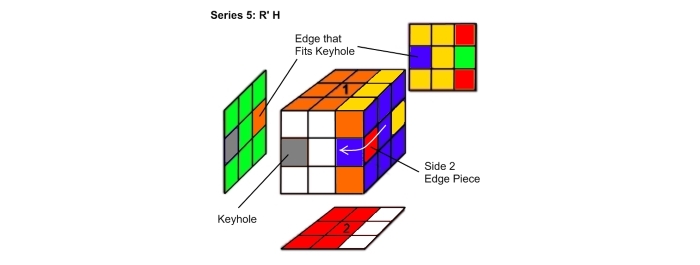
Series5: Fill in Keyhole: R’ H R2 H R’
H (Rotate the Horizontal (middle) slice clockwise looking from the top)
moves the "Edge Piece that fits the Keyhole" to the back (and thus the diagonal "Side 2 Edge Piece Opposite the Keyhole" moves to the front).
Step 5: Series5 Analysis: R' H R2
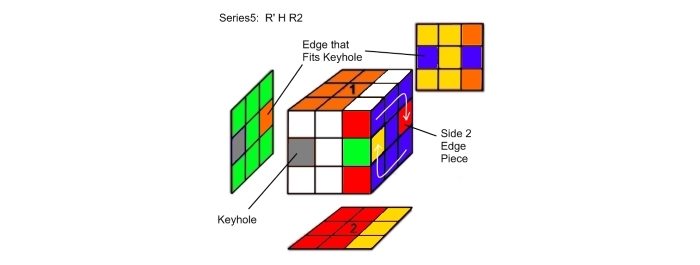
Series5: Fill in Keyhole: R’ H R2 H R’
R2 (rotate the right slice twice)
moves the "Side 2 Edge Piece Opposite the Keyhole" also to the back and places it adjacent to the "Edge Piece that fits the Keyhole". Note also how the Side 1 and Side 2 colors are directly opposite each other just like they should be.
Step 5: Series5 Analysis: R' H R2 H
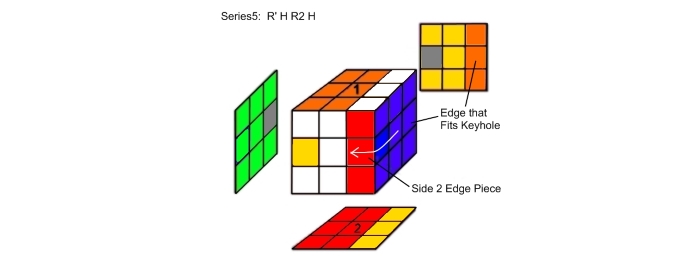
Series5: Fill in Keyhole: R’ H R2 H R’
H (rotate the Horizontal slice clockwise looking from the top)
moves the "Side 2 Edge Piece Opposite the Keyhole" and the "Edge Piece that fits the Keyhole" into place with their respective corner pieces. You can see now that you're practically done. One more turn of that right slice and you've successfully filled in the keyhole.
Step 5: Series5 Analysis: R' H R2 H R'
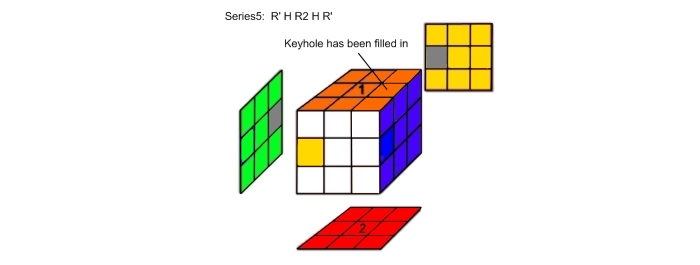
Series5: Fill in Keyhole: R’ H R2 H R’
R’ (rotate right slice counter-clockwise)
places that RH slice's Side 1 and Side 2 colors back where they should be. On to Step 6!
Step 6: Position the Four Remaining Pieces in the Middle Slice

You now have 2/3 of the cube completed – a top and bottom slice. You’re almost there!
That middle slice only has edge pieces to put in place. First, you'll need to get them into their proper positions. There are 3 scenarios that can occur:
1. All 4 center-edge pieces are in the correct position You got lucky! Move on to Step 7!
2. All 4 center-edge pieces are in the wrong position. Go to Step 6
3. Three of the center-edges are wrong and just 1 piece is in the correct position. Go to Step 6
Step 6: All 4 Center-edge Pieces Are in the Wrong Position
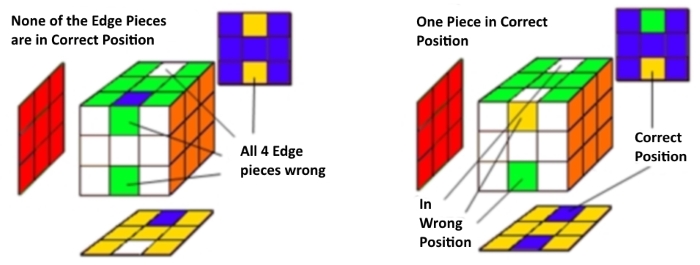
- If all 4 of your center edge pieces are in the wrong positions as shown in the left illustration (remember the center cube will tell you the correct color):
- Position the cube as shown, placing side 1 and side 2 (your completed sides) on either the right or left.
- Perform Series6 and you should end up with one of the pieces in the correct position. Now follow the directions below:
- If one piece is is in the correct position and 3 are not (as shown in the right illustration):
Position the cube as shown, placing the correctly positioned (not necessarily correctly oriented) center-edge piece to the bottom back of the cube so that it cannot be seen.
The three incorrectly positioned pieces will be visible as shown. Perform Series6 until each center-edge piece is in the correct position. You may need to do Series6 multiple times. When all the pieces are in their correct position, proceed to Step 7.
Series6: Rotate 3 edges in CCW direction: V U2 V’ U2
In words, rotate the middle vertical slice (between the orange and red sides) one quarter turn clockwise (looking from the right, i.e., away from you), the top side (green here) two quarter turns (half-way around), the vertical slice 1/4 turn counter-clockwise (back toward you), and the top half-way around again.
Series6 will move the 3 visible edge pieces around circularly in a CCW direction (looking from the right) while the hidden edge piece doesn’t get moved and remains in its place.
- V: moves the 2 face edge pieces to the top slice
- U2: swaps these 2 top edge pieces
- V’: moves the 2 swapped edge pieces back down to the face
- U2: swaps the 2 top edge pieces
Step 6a & 6b: Series6 Analysis: V U2 V’ U2
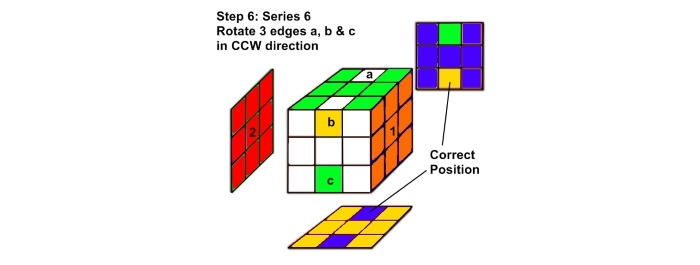
Series6 is a really easy series of moves. It will move the 3 visible edge pieces around circularly in a CCW direction (looking from the right) while the hidden edge piece doesn’t get moved and remains in its place.
Let's label these 3 edge pieces as a, b & c and let's take a detailed look at how this happens. Hold the cube as shown so that the solved slices (slice 1 & 2) are in your left and right hands. It doesn't matter which slice is in which hand - just hold it so that the middle slice you'll be working on is vertical and the correct edge piece is in on the bottom in the rear.
Step 6a & 6b: Series6 Analysis: V
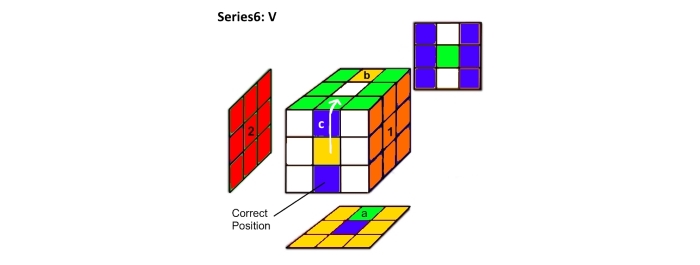
Series6: Rotate 3 edges in CCW direction: V U2 V’ U2
V: moves Edges c & b to the top slice
The 2 edge pieces c & b facing you need to change positions, so doing the V move (turn Vertical slice in CW (clockwise) direction looking from the right) will move those edges pieces c & b to the top slice where you can swap them.
Step 6a & 6b: Series6 Analysis: V U2
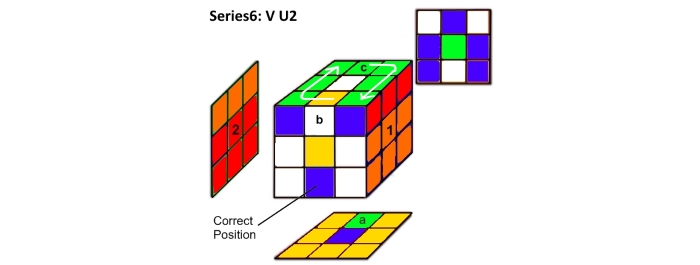
Series6: Rotate 3 edges in CCW direction: V U2 V’ U2
U2: swaps Edges b & c. Now c is adjacent to the "Correct Position Edge"
Step 6a & 6b: Series6 Analysis: V U2 V'
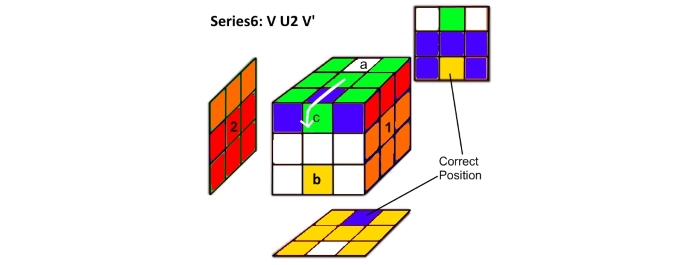
Series6: Rotate 3 edges in CCW direction: V U2 V’ U2
V’: simply moves the 2 swapped edge pieces back down to the face and puts the "Correct Position" piece back to the rear.
Step 6a & 6b: Series6 Analysis: V U2 V' U2
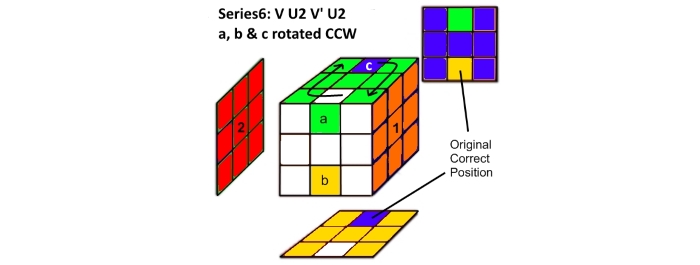
Series6: Rotate 3 edges in CCW direction: V U2 V’ U2
U2: swaps Edge pieces a & c and puts all the other corners & edges of that top slice back to where they're supposed to be to finish out the move.
Now a, b & c have been moved in a CCW direction while the Original Correct Position Piece (in the rear bottom slice) has stayed in the same position.
If you had one edge piece in the correct position and 3 that needed to change positions, you may need to do Series6 multiple times before those 3 end up in their correct positions
If you had all 4 edge pieces in incorrect positions, doing Series6 once should put one piece in it's correct position, so you'll do Series6 at least one more time and all 4 should end up in their correct positions and you can proceed to Step 7.
Step 7: Orient the Four Center-edge Pieces

You should now have a cube that’s almost complete, with 2 end slices done and a middle slice with edge pieces correctly positioned. All that’s left is to correctly orient these center-edge pieces! You’re so close, but this last series of moves is a real doozy!
These 4 middle slice pieces can be positioned 3 ways:
1. 2 pieces are correct and 2 adjacent pieces are misoriented (Fig 7a)
2. 2 pieces are correct and 2 diagonal pieces are misoriented (Fig 7b)
3. All 4 pieces are misoriented (Fig 7c)
- If 2 adjacent pieces are misoriented, Hold the cube so that the two misoriented center-edge pieces are on the top side of the cube as shown in the right illustration (Fig 7a) and perform Series7
Series7: V U V U V U2 V’ U V’ U V’ U2
- If you have 2 misoriented pieces diagonal to each other, position the cube as shown in the middle illustration (Fig 7b). Turn the Front (or Back) slice twice (F2) moving the misoriented pieces adjacent (next) to each other (i.e. make the cube look like Figure 7a). Now do Series7. Then turn it back (F2). So you’re making the cube look like Figure 7a, do Series7, and then turn it back. This adds 2 extra moves for the diagonal.case.
- Lastly, if all 4 pieces are misoriented (Fig 7c) you really got unlucky! Do Series7 twice, once for each pair.
We'll explain Series7 in more detail in the following slides.
Step 7a: Orient the Four Center-edge Pieces - Adjacent Misoriented Pieces
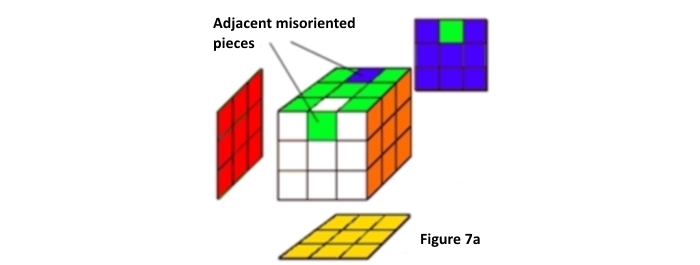
Let's explain Series7 using adjacent misoriented pieces:
Hold the cube so that the two misoriented center-edge pieces are on the top side of the cube as shown and perform Series7.
Series7: V U V U V U2 V’ U V’ U V’ U2
Series7 will flip the 2 misoriented edge pieces and is the hardest move to understand in this solution, but it's really not that hard to memorize.
Break this Series into 2 parts:
The first part is V U V U V U2 and that's pretty easy to remember. That's just turning the Vertical slice clockwise (looking from the right) followed by turning the Upper slice clockwise, and repeat. The third time, turn the Upper slice twice.
The second part is V’ U V’ U V’ U2 which is sort of the reverse of the first part, except you keep turning the Upper slice clockwise.
Let's examine Series 7 step by step in detail.
Step 7a: Series7 Analysis: Starting Position
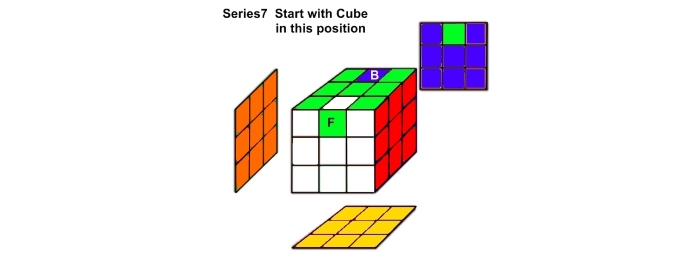
Let’s name the misoriented piece on the face F and the one in the back B.
Step 7a: Series7 Analysis V
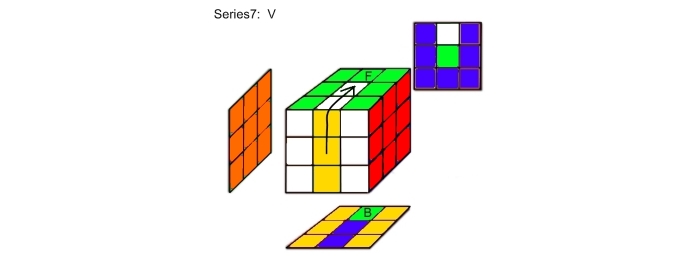
Series7: V U V U V U2 V’ U V’ U V’ U2
V: Moves both F and B to the back, F ends up on the top slice and B on the bottom slice.
Step 7a: Series7 Analysis V U
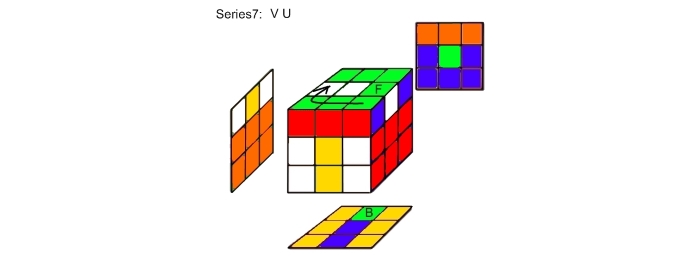
Series7: V U V U V U2 V’ U V’ U V’ U2
U: Moves F to the upper right side
Step 7a: Series7 Analysis V U V
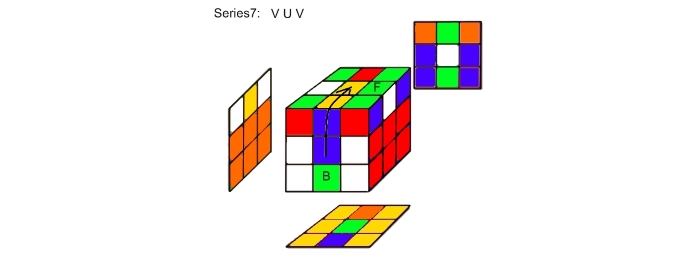
Series7: V U V U V U2 V’ U V’ U V’ U2
V: Moves B to the face onto the lower slice
Step 7a: Series7 Analysis V U V U
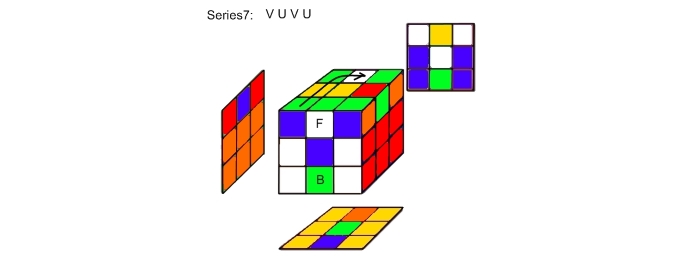
Series7: V U V U V U2 V’ U V’ U V’ U2
U: Moves F to the face onto the upper slice
Step 7a: Series7 Analysis V U V U V
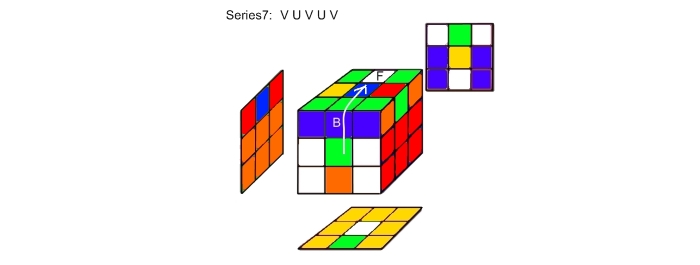
Series7: V U V U V U2 V’ U V’ U V’ U2
V: Moves F and B back to the top slice again, but now they’ve reversed positions. F is in the back and B is now at the front
Step 7a: Series7 Analysis V U V U V U2
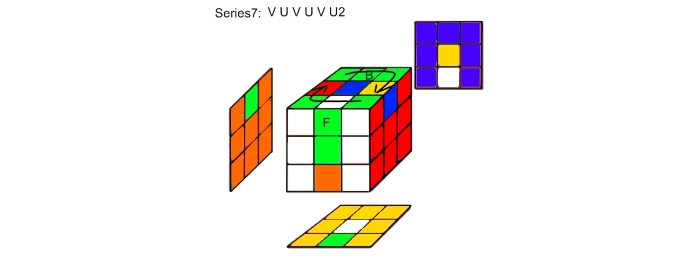
Series7: V U V U V U2 V’ U V’ U V’ U2
U2: Swaps F & B so that F is back at the Front and B is in the Back again
Step 7a: Series7 Analysis V U V U V U2 V'
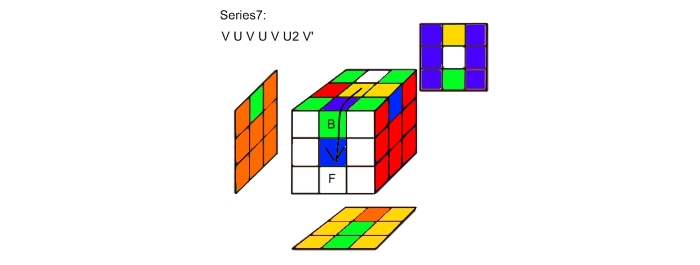
Series7: V U V U V U2 V’ U V’ U V’ U2
Now we “undo” the moves to get the rest of the cubes back into their correct positions.
V’: Moves F & B back to the face again
Step 7a: Series7 Analysis V U V U V U2 V' U
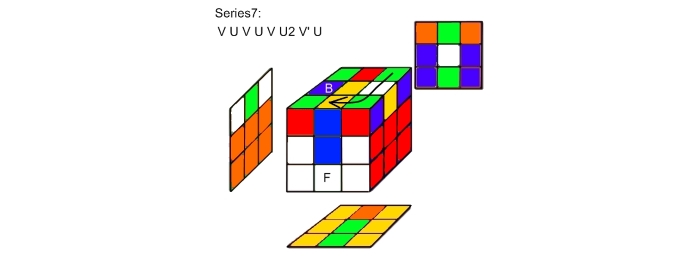
Series7: V U V U V U2 V’ U V’ U V’ U2
U: Moves B to the upper left side
Step 7a: Series7 Analysis V U V U V U2 V' U V'
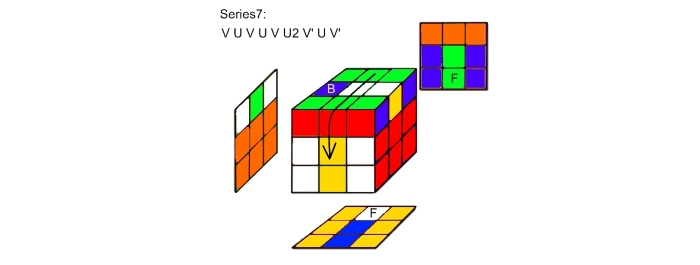
Series7: V U V U V U2 V’ U V’ U V’ U2
V’: Moves F to the back of the lower slice
Step 7a: Series7 Analysis V U V U V U2 V' U V' U
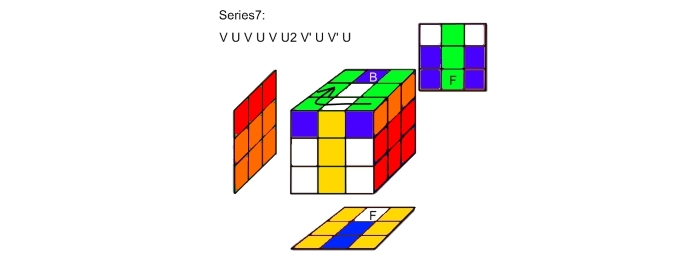
Series7: V U V U V U2 V’ U V’ U V’ U2
U: Moves B to the back of the upper slice, so now F & B are adjacent again and correctly oriented
Step 7a: Series7 Analysis V U V U V U2 V' U V' U V'
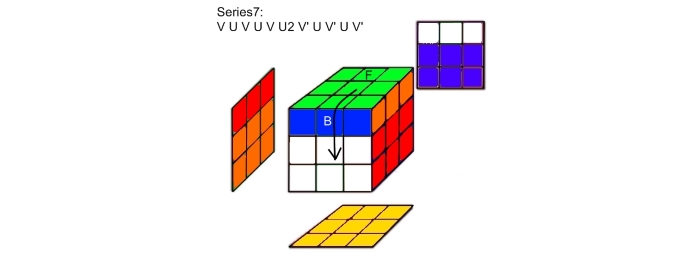
Series7: V U V U V U2 V’ U V’ U V’ U2
V’: Moves F & B back to the top slice
Step 7a: Series7 Analysis V U V U V U2 V' U V' U V' U2
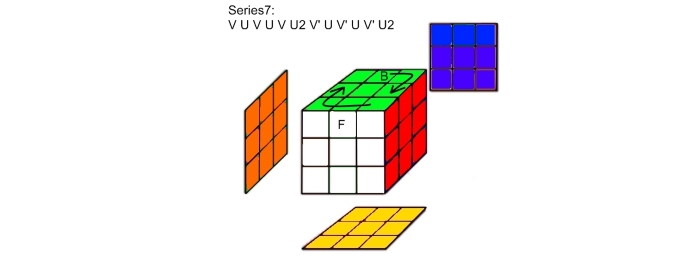
Series7: V U V U V U2 V’ U V’ U V’ U2
U2: Spins F & B back around and completes the cube (maybe – unless you are in a 7b or 7c situation).
Congratulations! You've Solved the Cube!
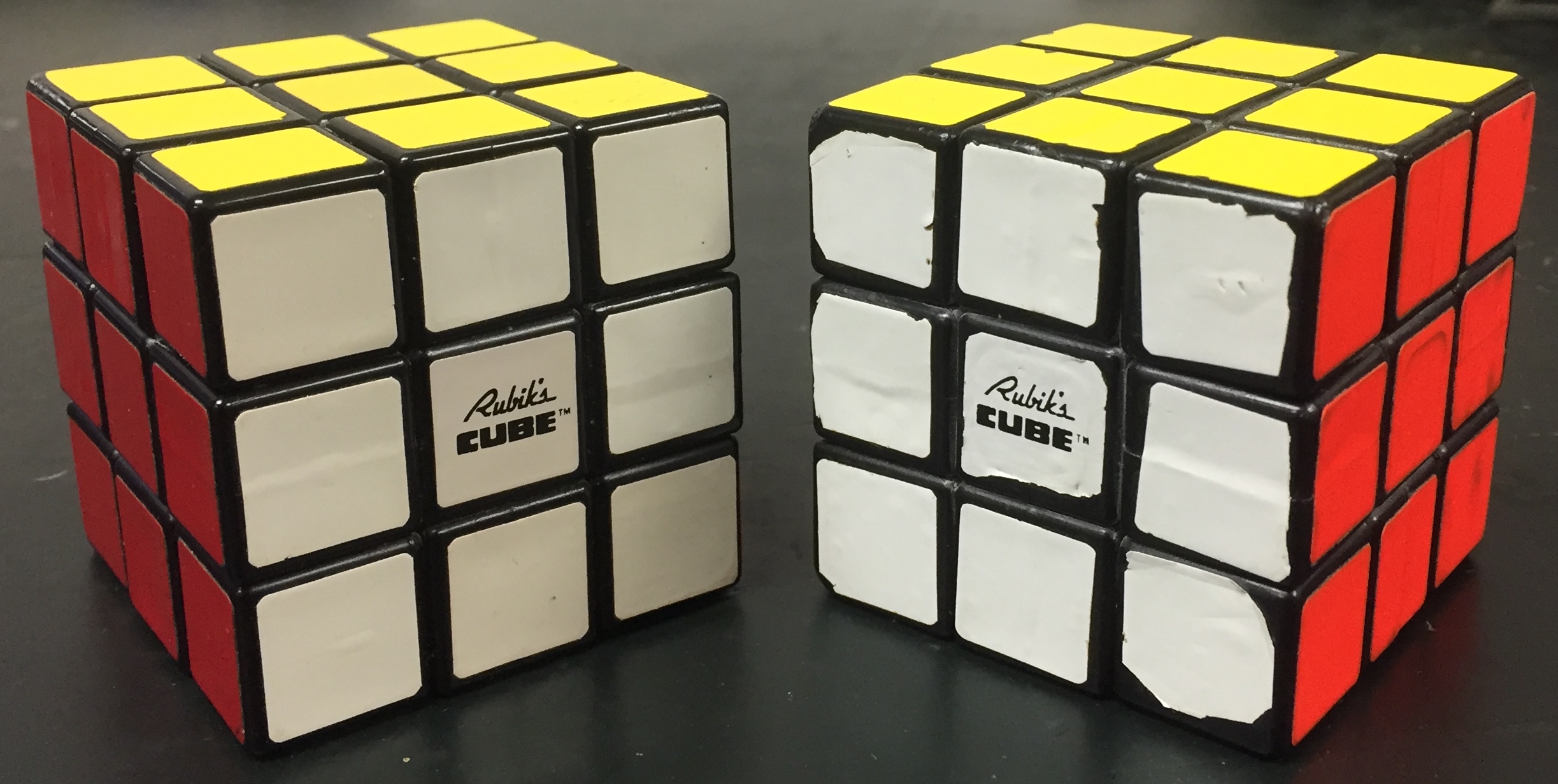
After doing Series7, your cube will be solved!
So as you can see, depending on how the cube was scrambled, you could either get lucky and solve the cube in as little as 60 moves using this method (about 30 seconds if you have fast hands and a smooth cube), or you might have nothing go your way and need up to 100 or more moves to grind it out (up to around 70 seconds). I probably averaged 50-55 secs back in the day. I never claimed this was the fastest solution, just the easiest!
This is an "Old School" solution; faster Old school "Corner's First" type solutions (more about these in the Appendix) will require more memorized moves but will give more solves consistently in the 60 move range so the variation between solves aren't as wide spread.
However, all my move series are short and easy to follow, and Series 3 and 4 are intuitive once you understand them, so hopefully it’s a solution you’ll always remember – I did, and I didn't touch a Cube for almost 20 years!
Summary
Ok, so you’ve waded through this entire solution, either that or you’ve skipped ahead to the end to read this summary (yeah, I don’t blame you, I do that too), and you’re thinking – “this ain’t easy at all! And what’s this about remembering this stuff? I can’t even understand or follow his lousy directions, much less remember any of it – this guy’s full of it.”
Well, granted, solving the Cube isn’t exactly a trivial matter – it’s supposed to be really hard! But it’s not rocket science either, or doesn’t have to be. Now Fridrich’s solution with something like 120 algorithms to memorize and the Petrus method, those are rocket science!
This solution really isn’t that hard. Hopefully, you follow the general concept for solving the cube and know the approach I’m taking (i.e., keyhole, top slice, bottom corners, bottom edges, then middle slice, position first, then orientation, etc. ) Let’s break the steps down.
Step 1. The first slice – it’s the same as just about any other method. Do whatever it takes!
Step 2. Positioning the bottom corners - very similar moves to the ubiquitous Top to Bottom Layer by Layer approach
- You spin the bottom slice until either 2 or 4 corners are in their correct positions.
- If you need to swap 2 corners, you check to see if they’re adjacent or diagonal.
- If adjacent, you do Series1 moves once. If diagonal, do Series1 moves a few times or do an alternative Series1.
Series1 moves are explained in detail to aid understanding so you don’t rely on muscle memory.
So Step 2 is moderately difficult, but not any more than other methods of positioning bottom corners. There’s only 1 series of moves of 8 steps you have to know (Series1 B’ F B R’ B R B’ F2). The 11 step move for the diagonal case is optional only if you’re wanting to be more efficient and going for more speed.
Step 3. Orienting the bottom corners
This step is the most complicated to explain and takes up the bulk of this tutorial, but it’s really easier than it appears. Just reading over what I’ve written for Step 3 gives me a headache, so I know how y’all must feel. So let’s try to summarize it.
The confusing part is really all the ways those corners can be oriented wrong. But once you can recognize the different cases, it becomes easier as the moves aren’t really that hard.
Case A: All 4 are correct so you’re done!
Case B: 3 wrong corners, so do Series2 (B’ F2 B F B’ F B F2) to flip all three: 8 steps and you’re done.
Case C: 2 wrong corners.
You have a choice – do Series2 a few times and you’ll eventually come up with Case B. Do Series 2 again and you’re done. Not the fastest way, but you’ll get there using that same move.
Or you can put a bit more thought into it and get it done faster by fixing one of the corners, moving its pair into that spot, and undoing the moves, thereby fixing the pair.
You can easily come up with your own moves for this, and then reverse them, so really there’s nothing to memorize here, but I give you 2 versions of what I do. There’s 2 versions because those pair of corner cubes can be flipped wrong in 2 ways – the top color can be facing Right & Left, or they can be facing forward. You’ll have to identify which way they’re facing and do the right moves.
I called my moves Series3:
Series3a: Flips 2 corner cubes if top color is facing right and left:
Part 1: R’ B’ R B R’ B’ R then move the partner piece of the pair into position
Part 2: R’ B R B’ R’ B R (reverse of 1st part - you’re basically undoing the moves with the partner piece)
Series3b: Flips 2 corner cubes if top color is facing you (Forward):
Simply switch the order of Series3a and you have Series3b:
Part 1: R’ B R B’ R’ B R
Part 2: R’ B’ R B R’ B’ R (reverse of Part 1)
It’s a long winded explanation but really quite a simple concept, and those 5 moves really don’t need to be memorized as you’re just flipping a corner piece any way you like and reversing those moves.
Case D: 4 wrong corners
Again it’s a lot of words and a long explanation, but really you just have 2 pairs of corners to flip instead of 1 pair, so it’s just Case C done twice. But you do have to figure out which 2 corners to pair together so there’s some thought involved, but again nothing difficult and no more moves to memorize.
So you can see Step 3 just requires some understanding and thought, but the moves are few and easy. Case C has 8 moves, and Case C only 5 moves that don’t need to be memorized.
Step 4. The 4 edge pieces of Side 2
Easy & intuitive – this is where that keyhole shines. You’re simply using the middle slice and the keyhole to stick in edge pieces into Side 2. I give you a 3 move series (Series4a: R’ H’ R, Series4b: R H’2 R’) but again, it’s so easy to follow and understand there’s no need to memorize this move either.
Step 5. Fill in that keyhole
Series5: R’ H R2 H R’ a 5 move series that fills in the keyhole that’s easily understood and memorized.
Optional for Case B: Series5a: (H) R H' R2 H' R (Opposite moves of Series5)
Step 6. Position the 4 remaining pieces in the middle slice
A simple process using Series6: (V U2 V’ U2) 4 moves that rotates 3 edge pieces around CCW, easy to comprehend and understand.
Step 7. Orient the 4 edge pieces in the middle slice
You’ll flip 2 edge pieces at a time here, so if you only have 2 edge pieces that need flipped, you’ll do Series7: (V U V U V U2 V’ U V’ U V’ U2) moves once and you’ve got a solved cube. If all 4 of the edge pieces are misoriented, you’ll repeat Series7 again and you’re done.
Series7 is one of the harder series of moves to understand, but it’s only 5 moves, then a twist of the upper slice, and then those 5 moves are reversed, so it’s nothing hard to comprehend and memorize either.
So there you have it. 7 steps and 7 move series that solve the cube.
- Series1: 8 moves B’ F B R’ B R B’ F2
- Series2: 8 moves B’ F2 B F B’ F B F2
- Series3: (optional) 7 moves forward then reversed - intuitive, come up with your own
- Series4: 3 moves - so intuitive there's no need to memorize
- Series5: 5 moves R’ H R2 H R’
- Series6: 4 moves V U2 V’ U2
- Series7: 6 moves forward V U V U V U2 then reversed V’ U V’ U V’ U2
All of them except for Step 2&3 are short with easily understood moves. Steps 2&3 (bottom corners) have more variations (cases) you’ll need to recognize, and two 8 move series (Series1 & 2) that are the more difficult ones, but the layered solutions also have to deal with these bottom corners the same way. Steps 4,5 & 6 are easy, and then there's that last Step7 - hard to comprehend, but luckily easily memorized.
So this solution really only has 3 algorithms (Series 1, 2 & 7) that I'll admit take a bit of understanding to commit to memory and 2 (Series 5&6) that are so simple they become second nature. So if you haven’t already, give this solution a try!
My Solution Is a Keyhole Method
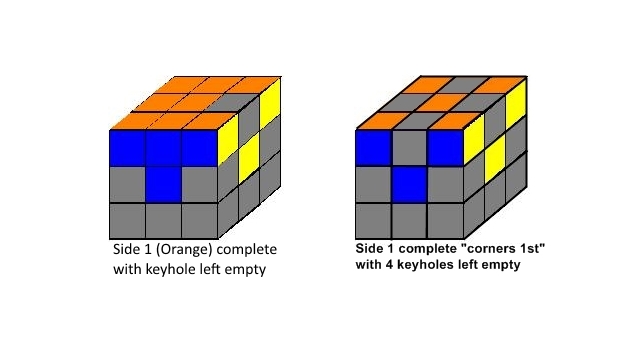
Some astute readers will inevitably point out that all keyhole methods are really just variations on the corner's first method. Yes, you could leave out the edge pieces on that first slice and only do the corners and thus have four keyholes instead of just one (actually 12 keyholes since all 6 edges are now potential keyholes!). I'll address the pros and cons of that in the Addendum. For now I'll proceed with using a single keyhole as this is the way I'm accustomed to approaching it and it's easier to explain with one keyhole than four (or 12!).
I do repeat some moves over and over again until the cubes pop out correctly at the expense of speed and some moves will rotate certain pieces around in a fixed, repetitive pattern, so depending on how the cube was messed up you may cycle through the pattern only once if you’re lucky, or several times if you’re not before the desired outcome happens. So the number of moves and therefore solving time will vary.
I make no claims that this approach is the fastest. This is definitely NOT a speedcubing solution! This is Old School, the way we did it back when the Cube was new! Speedcubers will always have a solution that solves a cube in a consistent number of moves (around 55-60) so they'll have a specific set of moves for every situation and never have to rely on dumb luck for a fast solve or resort to repeating moves, so their methods require a lot more recognized patterns and memorized moves, and a lot more 3 dimensional spacial ability and memory as the speedcuber needs to visualize many moves ahead much like a chess master.
This method isn't the slowest either - those are usually the top to bottom layered solutions as they most always require a lot of moves (130+) and use more algorithms and more complicated algorithms that are hard to understand and remember, at least for me! Corner's first methods were actually favored by speed cubers in the 80's when solves in the 20 to 30 second range were winning competitions, and have only recently (ok, recently for me would be this century - the 2000's!) been supplanted by the more exotic solutions such as the Fridrich, Roux, ZZ and Petrus methods (found these on the internet - I don't claim at all to know them!).
What sets this method apart is it’s one you have the best chance of remembering! Compared to all the solutions I’ve seen, it uses the fewest series of moves (algorithms) with the fewest number of moves per series, and a large part of the solution relies more on simple intuition and common sense than muscle memory. I will explain each move in detail to help you understand what’s happening, what each move does and why you’re doing it so that you implicitly know what to do and have less reliance on muscle memory which trust me, fades with time and lack of practice.
Appendix A: This Keyhole Method Is a Corner's First Variation

As I alluded to in Slide 1, this Keyhole Method is really a variation on a Corner's First method except I fill in the 1st layer edge pieces early. If I'd ignored all the edge pieces and kept all 4 edge pieces on the 1st slice empty and had 4 keyholes instead of just 1, this would be considered a Corner's First method instead.
Corner's first is an "old school" method and were the fastest methods back in the 80's until maybe the mid to late 90's? There are many variations of Corner's First methods, the fastest and most well known being Minh Thai's (1982 World Record holder) and Jeff Varasano's (1982 US Record). Mine is not one of the fastest ones - I use fewer algorithms so if you're unlucky on the scramble, you may have to repeat algorithms more than once, adding moves and eating up time, so the number of moves (and hence time) is inconsistent. I give up speed for ease of understanding and memorization.
Step 1: Solving Corners First instead of Keyhole should make Step 1 (solving Slice 1) quicker since you're not hunting for edge pieces and only solving for corners. But I notice I have trouble spotting the corners and where they go as quickly as I do edges. Maybe it's just me and what I'm used to, or maybe you just can't teach an old dog new tricks! It could also take a couple fewer moves to get a corner piece in place without having to worry about messing up previously placed Edge pieces.
Step 2 & 3, solving the corners on Slice 2, would be exactly the same.
Step 4 would be done the same way as I've described, except you'd have every edge on the entire cube to use as a keyhole so filling in Side 2 edge pieces should be faster since you're not tied to always aligning and using a single keyhole! Yes, since all corners are done and none of the edges, this means any color side can now become your Side 2! You're no longer tied to the same 2 colors as Side 1 & 2 as you are with the Keyhole method where Side 1 is set and mostly complete - take a good look at the illustration on the right and you should see what I mean. With Corner's First, you can choose the side that just happens to be mostly complete (i.e., has the most edges pieces already correct) as your new Side 1 or look at the 3 possible middle slices (yes 3) to see which contains the most of one color edges, and therefore choose that color to be a Side 1 or Side 2 color.
Using Corner's First, you're not tied to using a single keyhole and a predetermined Side 1 & 2, so it could be faster if there's a side that just happens to be mostly done, or a middle layer (out of 3 possible) that just happens to contain more edges of the same color.
Yes, you'll have to fill in the Side 1 edge pieces as well as Side 2 edges (using the same methods), so you'll spend more time on Step 4 just because you have 3 more edge pieces to put in place. Still, overall this might be just a bit faster since there's fewer places for those edge pieces to be so maybe it'll be quicker to find them and get them into place.
The remaining steps 5, 6 and 7 remain the same regardless of whether you've used a Keyhole or Corner's First.
So, reserving all the edge pieces until later and solving all the corner's first might save a bit of time if the time saved in Step 1 offsets the longer time Step 4 takes. It doesn't really change this method or series of moves used at all. The reason I didn't approach this tutorial as a Corner's First method was the following:
1. I didn't realize I could have done it doing just the corners and having essentially 12 keyholes to choose from back 33 years ago (as of 2014) as I probably had tunnel vision intent on solving an entire slice first, so just the simple realization that I could use an edge piece as a "keyhole" to make completing the Side 2 edge pieces easier was a novel enough concept to me at the time. Actually I'd never heard the terms "keyhole" and "corner's first" in regards to cubing until I started looking at solutions on the internet a year ago!
2. I think it's easier to explain to a beginner the concept of using a single keyhole first, instead of having them visualize 4 keyholes and no completed side, so I stick to using the keyhole to teach my solution.
For someone that fully understands this approach, attacking it Corner's First might be a slightly faster way to go.
Appendix B: Keyhole Vs Corners First Analysis With Real Data
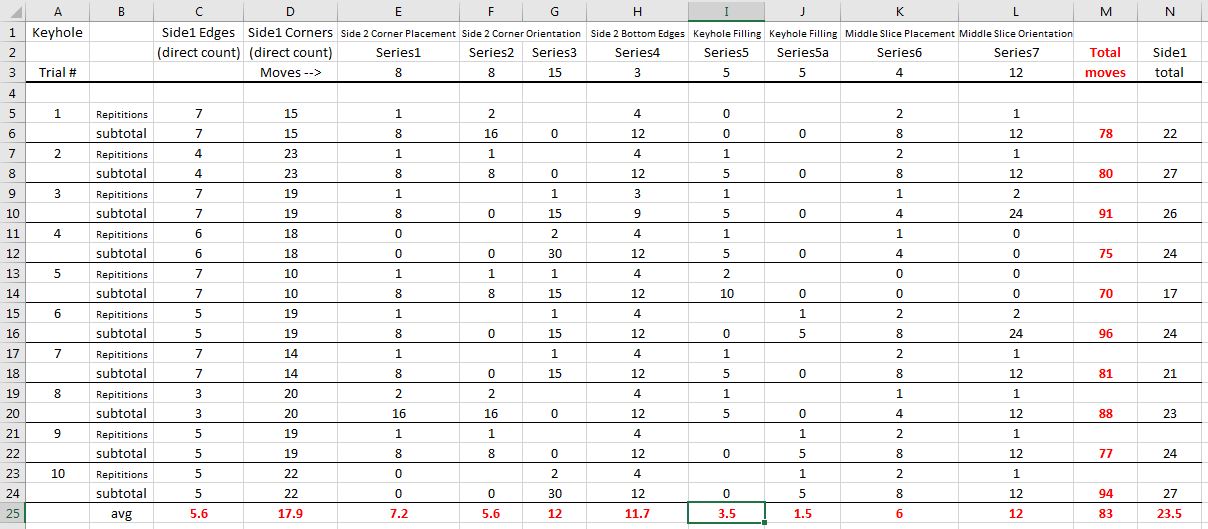
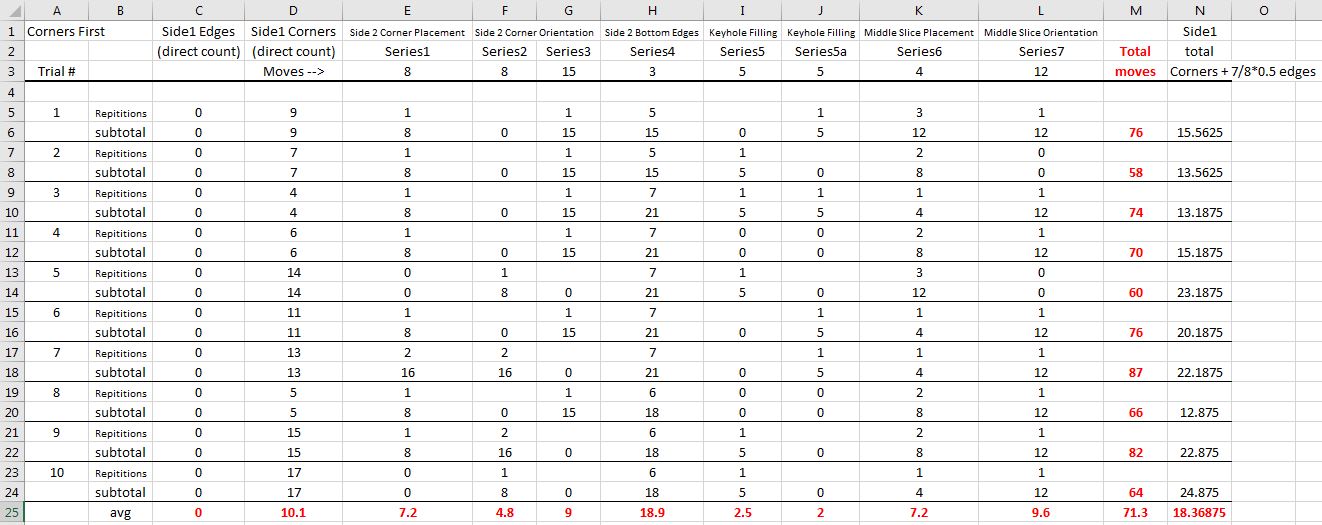
Revision History
5-20-2014 Rev 1.0 Initial Revision
5-21-2014 Rev 1.1 Added Summary and Revision History
5-28-2014 Rev 1.2 Revised Slides 34-37 for clarity (Step 3b Case c), Added info to Slide 1, Added Appendix A
5-30-2014 Rev 1.3 Edited Steps 2 & 3 for clarity, edited illustrations to clarify how pieces of interest move around
5-31-2014 Rev 2.0 Edited illustrations in Steps 2 & 3 and added arrows to show how slices are to be turned. Added detailed analysis of Step 6, Series6.
6-05-2014 Rev 2.1 Various minor edits for clarity. Changed Slide 6 illustration for clarity.
6-12-2014 Rev 3.0 Added detailed step by step analysis of Series7.
3-10-2018 Rev 3.1 Edited photos for size & sharpness and revised some wording for clarity.
3-15-2018 Rev 3.2 Added Series5a.